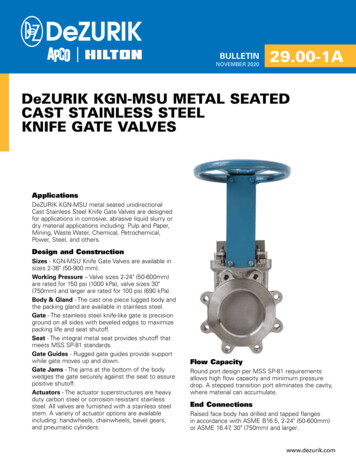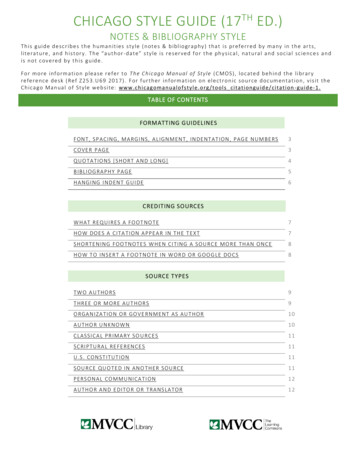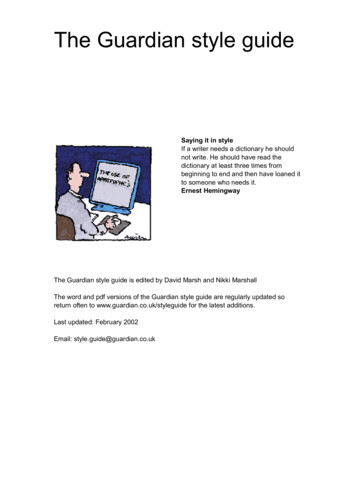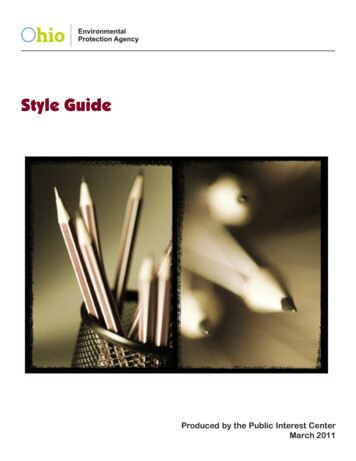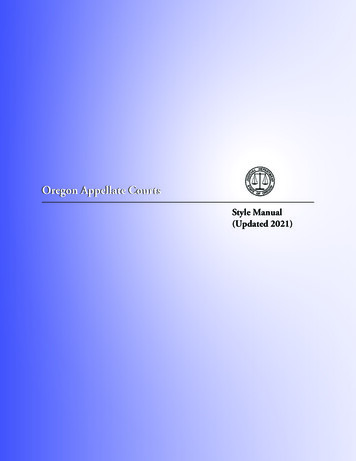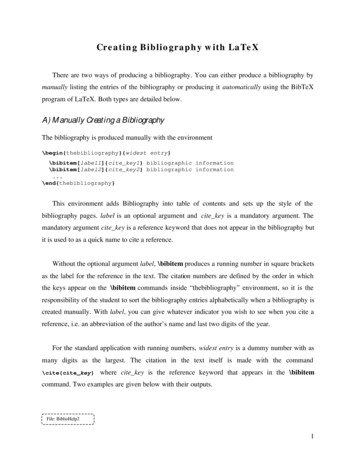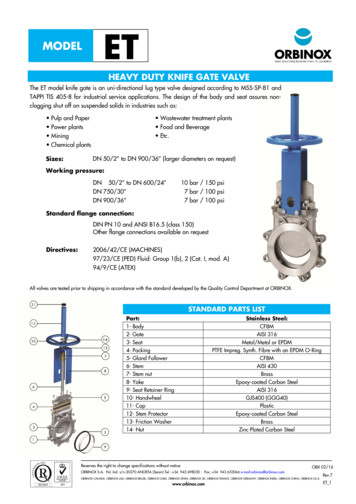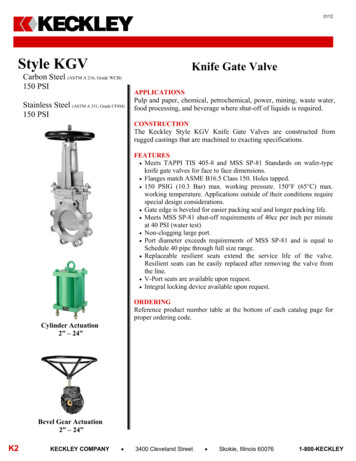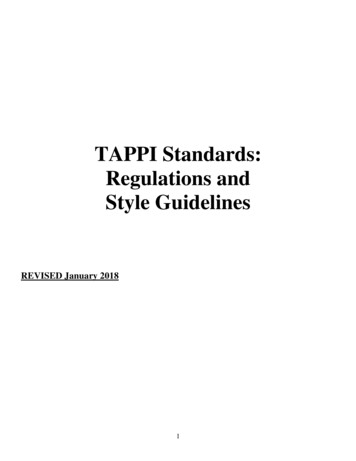
Transcription
TAPPI Standards:Regulations andStyle GuidelinesREVISED January 20181
PrefaceThis manual contains the TAPPI regulations and style guidelines for TAPPI Standards. The regulations andguidelines are developed and approved by the Quality and Standards Management Committee with the adviceand consent of the TAPPI Board of Directors.NOTE: Throughout this manual, “Standards” used alone as a noun refers to ALL categories ofStandards. For specific types, the word “Standard” is used as an adjective, e.g., “Standard Test Method,”“Standard Specification,” “Standard Glossary,” or “Standard Guideline.”If you are a Working Group Chairman preparing a Standard or reviewing an existing Standard, you will find thefollowing important information in this manual: How to write a Standard Test Method using proper terminology and format (Section 7) How to write TAPPI Standard Specifications, Glossaries, and Guidelines using proper terminology andformat (Section 8) What requirements exist for precision statements in Official and Provisional Test Methods (Sections4.1.1.1, 4.1.1.2, 6.4.5, 7.4.17). Use of a checklist to make sure that all required sections have been included in a Standard draft(Appendix 4). How Working Group Chairman, Working Groups, and Standard-Specific Interest Groups fit into theprocess of preparing a Standard (Section 6.3, 6.4.1, 6.4.2, 6.4.3, 6.4.4, 6.4.6, 6.4.7). How the balloting process works (Sections 6.4.6, 6.4.7, 6.4.8, 6.4.9) How to resolve comments and negative votes (Sections 9.5, 9.6, 9.7)NOTE: This document covers only the regulations for TAPPI Standards, which may include Test Methods orother types of Standards as defined in these regulations. A separate set of regulations is available for TechnicalInformation Papers (TIPs).2
Table of ContentsPage1.Scope42.Introduction43.Referenced Standards44.Categories of TAPPI Standards65.Definitions and Terminology106.Procedures for Review and Approval of TAPPI nsSubject Categories and Standard-Specific Interest GroupsPreparation proceduresCorrections and revisionsReclassification of Test MethodsMiscellaneous proceduresReview of StandardsCompliance with ANSI PoliciesRetention of recordsSubmission of TAPPI Standards to become American National StandardsInterpretations policyAdditional informationFormat and style of TAPPI Test Methods and Standard gyFormatContents of sectionsAdditional informationFormat and Style of TAPPI Standard Specifications, Glossaries, and ontents of sectionsChecklistResponsibilities of Working Group ChairmenAppendix 1.Appendix 2.Appendix 3.Appendix 4.Appendix 5.Appendix 6.Appendix 7.Appendix 8.Index53History of Standards ProgramTAPPI Antitrust PolicyResolution of Comments and Negatives FormWorking Group Chairman’s ChecklistFlow ChartsSupplemental Keyword ListSubject Categories for TAPPI Test MethodsRelated Methods Chart3566164666872767885
TAPPI StandardsRegulations and Style Guidelines1.ScopeThis manual describes the procedures and policies whereby TAPPI Standards are developed and published, andthe guidelines for style and format of these Standards.2.Introduction2.1The overall management of the TAPPI Standards program, including the content of theseRegulations and Style Guidelines, is the responsibility of the Quality and Standards Management Committee ofthe TAPPI Board of Directors, with the advice and consent of the Board. Q&SMC may, with advice andconsent of the Board, from time to time revise these Guidelines in order to provide continuity and continualimprovement of the TAPPI Standards program. Editorial changes may be made by approval of the Q&SMCChairman.2.2A detailed history of the TAPPI Standards program, from its beginning around 1920 through1992, is reprinted in Appendix 1. Appendix 8 is an extensive cross reference of ISO, TAPPI, and ASTM testingprocedures for pulp, paper, paperboard, packaging, and related materials.2.3TAPPI Standards, including Test Methods, Specifications, Glossaries, and Guidelines, arepromulgated for the information of the industries TAPPI serves. Some standards may, as appropriate, bevoluntarily adopted by a willing buyer and willing seller in their purchase and sale contract. TAPPIstandards are promulgated following notice and the participation of interested parties (typicallyincluding buyers, sellers, suppliers and customers) in a deliberative process involving Standard-SpecificInterest Groups which are open to all interested parties. TAPPI standards are not intended, and shallnot be used, to limit or otherwise restrict innovation, output, or the range of choices available tocustomers or consumers. Any questions or concerns regarding a TAPPI standard should be directed tothe TAPPI Standards Administrator.3.Referenced Standards3.1The following documents are referenced in these guidelines:TAPPI Antitrust Policy (Appendix 2)TAPPI Test Methods, including:T 1200 “Interlaboratory Evaluation of Test Methods to Determine TAPPI Repeatability andReproducibility”T 1205 “Dealing with Suspect (Outlying) Test Determinations”T 1210 “Units of Measurement and Conversion Factors”TAPPI Useful MethodsTAPPI Technical Information Papers, including:TIP 0800-01 “Units of Measurement and Conversion Factors”ISO StandardsASTM StandardsANSI/ASME Y1.1-1972 (R1984) “Abbreviations for Use in Drawings and in Text”4
3.2TAPPI Standards may be ordered from TAPPI PRESS in CD-ROM or print-on-demand formats.Individual documents are also available in hard copy or electronically. In addition, a company license for accessto all TAPPI Standards and Technical Information Papers for an annual fee, is available. For price information,visit the TAPPI website at www.tappi.org, or contact TAPPI Member Connection for price information: 1-800332-8686 (U.S.) or 1-800-446-9431 (Canada).3.3For Working Group Chairmen who are completing revision or review of TAPPI Standards, onecopy of each related standard or method from other organizations which may be on file at TAPPI may beobtained at no cost by request from the TAPPI Standards Administrator. Fair-use copyright laws prohibit anyother copies to be distributed. Any additional copies of such Standards must be purchased from the appropriateorganization.The TAPPI contact information is:TAPPI15 Technology Parkway SouthNorcross, GA 30024U.S.A.Phone: 1 770-446-1400Fax: 1 770-446-6947email: memberconnection@tappi.orgwww.tappi.orgASTM Standards may be ordered from:ASTM100 Barr Harbor DriveWest Conshohocken, PA 19428-2959U.S.A.Phone: 1 610 832-9500Fax: 1 610 832-9555email: service@astm.orgwww.astm.orgISO Standards may be ordered from:ANSI25 West 43rd StreetNew York, NY 10036Phone: 1-212-642-4900Fax: 1-212-398-0023www.ansi.orgGlobal Engineering Document Sales15 Inverness Way EastEnglewood, CO 80112phone: 1-800-854-7179fax: 1 303-397-2740email: globalcustomerservice@ihs.com5
4.Categories of TAPPI Standards4.1 TAPPI Standards may be in the form of Test Methods or as other documents (includingspecifications, guidelines, glossaries, practices) that have been developed as TAPPI Standards through theconsensus of a technical working group (defined in these guidelines as Standard-Specific Interest Groups)acting in accordance with the procedures described in these guidelines. TAPPI does not engage in activities orpublish Standards that could lead to standardization of products or services in ways that would reducecompetition, impede the development of improvements to those products or services, or would result in astabilization of costs for those products or services.4.1.1 TAPPI Standard Test Methods are testing procedures and related practices used in themeasurement, evaluation, and description of pulp, paper, packaging, and related products, including rawmaterials used in their manufacture, use, or in scientific investigations of any such substances. Included as partof the methods are various classifications of methods and practices as defined in Sections 4.1.1.1-4.1.1.6.4.1.1.1 Standard Official Method: A testing procedure which has qualities of accuracy and precisionsuch as to make it meet all of the following requirements:1.2.3.4.5.6.7.8.The testing procedure is applicable to the evaluation of pulp, paper, packaging, or relatedproducts, or of materials that possess a measurable property of special or unique importance tothe pulp, paper, packaging, and related industries.For methods not specific to a particular instrument, equipment used in the procedure is describedin sufficient detail to enable the user to check its operation and compliance with the procedureeither by well-known means or by means described in the testing procedure to achieveacceptable results.For methods specific to a particular instrument, equipment used is described in the procedure insufficient detail to be understood or acquired by the user. Instructions for its use may either beincluded in the method or listed in a published instrument manual. The name of the manufactureror distributor of the instrument shall not appear in the method, unless the instrument name isneeded to differentiate the method from another TAPPI method purported to measure the sameproperty. Names of suppliers will be available through the TAPPI Standards Administrator aspart of the Suppliers List, which is also published in the full set of Test Methods.The procedure is described in sufficient detail to enable a trained technician to put it into practiceand obtain results with the stated precision or accuracy.The testing procedure consists of only one procedure with a definite series of steps for testingeach property, unless any alternative procedure or step yields identical results for that propertywithin the stated precision.The testing procedure states the units in which the results are to be reported. If it has beendeemed desirable to permit the use of alternative units, the preferred units are to be noted.A testing procedure which produces numerical results contains a statement of precisionembodying values of repeatability and reproducibility (as defined in T 1200 “InterlaboratoryEvaluation of Test Methods to Determine TAPPI Repeatability and Reproducibility”) or astatement that such values cannot practicably be determined.The testing procedure may contain expressed or implied product, material, or equipmentspecifications in any form only to the extent that such specifications are necessary to specify thetest equipment or material required to carry out the method.4.1.1.2 Standard Provisional Method: A testing procedure which meets all the requirements for anOfficial Method except for extensive history in its use. If it produces numerical results, it is required to have aprecision statement containing at least a value for within-laboratory precision, as described in T 1200“Interlaboratory Evaluation of Test Methods to Determine TAPPI Repeatability and Reproducibility.” A testing6
procedure may remain a Provisional Method for a maximum of five (5) years, within which time it must bereviewed and then be advanced to an Official Method or withdrawn.4.1.1.3 Standard Practice: An accepted procedure for the performance of one or more operations orfunctions associated with TAPPI Test Method activities. "Sampling and Accepting a Single Lot of Paper,Paperboard, Containerboard or Related Product" (T 400), "Forming Handsheets for Physical Tests of Pulp" (T205) and "Static Creasing of Paper for Water Vapor Transmission Tests" (T 465) are examples of TAPPIStandard Practices at the time of issue of these guidelines. Practices may include, but are not limited to,documents regarding installation, maintenance and operation of testing apparatus, sampling or selection ofmaterials for testing, and documents giving general guidance for making particular types of measurements orpreparing test specimens for such measurements. Standard Practices carry the designation “sp” in the suffix ofthe identifying number and must be balloted and reviewed as if they were Official Methods. The requirementsfound in Sections 5, 6, and 7 of these guidelines apply to both methods and practices except where specificdifferences are noted.4.1.1.4 Standard Classical Method: A testing procedure, usually a former Official Method, which isno longer in common use, or which has been superseded by advanced technology. These testing procedures aretechnically sound, have a history of use, and may contain a body of literature references that make theirpreservation valuable. Classical Methods are part of the current set of TAPPI Test Methods and shall bereviewed every 10 years, following the procedure as outlined in Section 6.8 of these guidelines.4.1.1.5 Useful Method: A document written to describe a test, procedure, or practice which may beproposed by a Working Group of no fewer than three TAPPI members not employed by the same organizationand written in the same general style as a TAPPI Standard Test Method, but with the inclusion or exclusion ofcertain sections as deemed appropriate by the Working Group, and with minimum precision requirements thatmay be expanded at the discretion of the Working Group. TAPPI Useful Methods are not Standards as definedin these guidelines, and a separate set of guidelines for the development and review of Useful Methods has beendeveloped (approved initially by Q&SMC by email vote in July 2010).4.1.1.6 The suffix following the Test Method number indicates the category of the method. Test Methodnumbers consist of a capital T, followed by a space, then a number (assigned sequentially within several TestMethod categories), another space, a two-letter designation of classification, a hyphen, and the last two digits ofthe year published.4.1.1.7 The subject areas and their numbering are:Fibrous Materials and Pulp TestingPaper and Paperboard TestingNonfibrous Materials TestingContainer TestingStructural Materials TestingTesting PracticesT 1-200 SeriesT 400-500 SeriesT 600-700 SeriesT 800 SeriesT 1000 SeriesT 1200 SeriesNumbers for new Test Methods are assigned sequentially.withdrawn method is reinstated.7Withdrawn numbers are not reused unless a
4.1.1.8 The two-letter designations for classifications of Test Methods are:om Official Methodpm Provisional Methodsp Standard Practicecm Classical MethodIn the Numerical Index, the designation “wd” indicates that the method has been withdrawn. The “UM”designation for Useful Methods appears also in references to these documents.4.1.1.9 Example: A new Provisional Method for testing containerboard adopted in 1993 might bedesignated as: T 830 pm-93.4.1.2 TAPPI Standards may also include certain specifications, definitions, glossaries, technicalinformation, or guidelines that are unrelated to Test Methods. Although similar documents may exist in theTAPPI Technical Information Papers (TIPs) set, the documents that become a part of the Standards set mustcomply with the Standards regulations in their development and approval.4.1.2.1 TAPPI Standards that do not fall under the Test Methods category will be numbered beginningwith T 1500, and shall be numbered consecutively in this T 1500 series. The number shall consist of a capital T,followed by a space, then the number, another space, a two-letter designation of classification, a hyphen, andthe last two digits of the year published.4.1.2.2 The two-letter designations for classifications of documents in the T 1500 series are:ss Standard Specificationgl Standard Glossarysg Standard GuidelineIn the Numerical Index, the designation “wd” indicates that the method has been withdrawn.4.1.3 Withdrawn Standards: Any TAPPI Standard may be withdrawn for one of two reasons:4.1.3.1Guidelines.Any TAPPI Standard may be withdrawn following the procedures in section 6 of these4.1.3.2 Withdrawn TAPPI Standards, Administrative: When an SSIG withdraws the method foronly administrative reasons such as lack of continued interest in the method, or inability to find laboratorieswilling to participate in developing a precision statement, or similar non-technical reasons, the method shall beconsidered withdrawn administratively (wa). A TAPPI Standard may also be withdrawn because of lack ofcompliance of an SSIG or Working Group Chairman with the administrative procedures in Section 6 of theseGuidelines, and particularly as described in 6.4.6.7, shall be described as “withdrawn administratively (wa).”4.1.3.2.1 Administratively withdrawn Standards, whether withdrawn by an SSIG or by Q&SMC action,shall no longer be published as a part of the active TAPPI Standards, but may be purchased from TAPPI. Whensuch administratively withdrawn standards are distributed in any hard copy or electronic form of any type, theyshall be clearly identified as a withdrawn Standard, the fact that the method has been administrativelywithdrawn, and the date of withdrawal.4.1.3.2.2 In any case where a Standard comes to the attention of Q&SMC under the provisions of6.4.6.7 of these Guidelines, if the ballot history of the document, or technical knowledge from a member or8
members of Q&SMC indicates that technical issues are preventing a successful completion of balloting,Q&SMC may, in its sole judgment, and in compliance with 6.4.6.7 administratively withdraw the Test Methodbut indicate the withdrawal as having been technically withdrawn (see Section 4.1.3.3).4.1.3.3 Withdrawn TAPPI Standards, Technical: Any TAPPI Standard that is withdrawn for anytechnical reason (safety concerns, method provides erroneous results, or similar technical reasons) shall beballoted for withdrawal by an appropriate SSIG following the procedures of Section 6 of these Guidelines.Upon successful ballot to withdraw, it shall be designated as “Technically withdrawn (wt).” Such technicallywithdrawn Standards, whether withdrawn by an SSIG or by Q&SMC action, shall no longer be published as apart of the active TAPPI Standards, and shall no longer be available for purchase from TAPPI.4.1.3.4 Withdrawal of American National Standards. Any TAPPI standard that has been approvedas an American National Standard must be withdrawn as a national standard whenever the TAPPI standard hasbeen withdrawn or reclassified as a Classical Method. The BSR-8 form shall be submitted to ANSI in the caseof withdrawal of a TAPPI national standard.9
5.Definitions and Terminology5.1 The following definitions describe the persons or groups or people involved in the TAPPI Standardsprogram:5.1.1 Standard-Specific Interest Group (SSIG): A group of persons including members and nonmembers of TAPPI who have an interest in being a member of the group which votes on a particular Standard.Permanent members of the Standards-Specific Interest Group (SSIG) shall be members in good standing ofTAPPI; voting members will include permanent members plus other TAPPI members or nonmembers whoindicate an interest in the Standards and have chosen to submit a vote. See Section 6.4.3 for the requirementsregarding the makeup of SSIGs. The SSIG is the Consensus Body for American National Standards (“ANSs”).5.1.2 Standards Advisory Review Group: A group of TAPPI members appointed by the Quality andStandards Management Committee (Q&SMC) who are familiar with the TAPPI Standards process and arequalified to participate in reviewing appeals filed during the process of developing new Standards or reviewingcurrent standards and to participate in the final review of Standards after they have been approved by theappropriate SSIG. The Standards Advisory Review Group (SARG) is responsible for determining that theStandards review and/or development process has been properly followed, and that all negatives and commentshave been resolved as required by these regulations. The SARG members are appointed to terms whose lengthsare determined by the Q&SMC. The SARG shall have a minimum of three members, but may have as many asthe Q&SMC deems appropriate.5.1.3 Working Group: A group of persons, which may include both TAPPI members and nonmembers, assigned a specific Work Item with regard to the TAPPI Standards program (see Section 6.4.4).Working Groups (WGs) are created and discharged by the TAPPI Standards Administrator with the advice ofappropriate Standard-Specific Interest Groups. The method of managing the tasks of the WG is through theWork Item (WI) system (see 5.2.1); thus a SSIG generally has specific responsibility for a specific WI. A WGmay be, and frequently is, a subset of a Standard-Specific Interest Group.5.1.4 Working Group Chairman: A member of a working group recruited by the StandardsAdministrator to direct the activities of the WG responsible for a particular WI. For simple Standards revisiontasks, the Working Group Chairman (WGC) may be the only member of the working group.5.1.5 Subject Category: An entry on a listing of technical areas relating to the pulp, paper, packaging,and allied industries. The listing is maintained by the TAPPI Standards Administrator and is used fordetermining areas of interest for Standard-Specific Interest Groups. The numbers assigned to the SCs are alsoused in the numbering system for TAPPI Technical Information Papers (see the guidelines for TAPPI TechnicalInformation Papers). The listing of Subject Categories may be found in Appendix 7 of these guidelines.5.1.6. Quality and Standards Management Committee. This Committee, frequently referred to byits initials, Q&SMC, is appointed by the TAPPI Chairman of the Board, and it reports to the TAPPI Board ofDirectors. Its scope is:The Quality and Standards Management Committee is responsible for administration and maintenanceof the procedures and guidelines relevant to TAPPI Standards, Technical Information Papers, and UsefulMethods. The Committee maintains liaison with internal and external groups as appropriate, includingANSI as it relates to TAPPI’s accreditation as a standards development organization. The Committeebrings major policy proposal changes to the Board of Directors.The Q&SMC has become active in coordinating TAPPI relationships with several other groups,including the U. S. Technical Advisory Groups (TAGs) to ISO (International Organization for Standardization)10
TC 6 (Pulps, Paper, and Paperboard), ISO TC 176 (Quality Management), and the American Society of Testingand Materials (ASTM) D06 Committee on Paper and Paperboard. Another activity of Q&SMC is review ofStandards which are overdue for required 5- or 10-year review.The Q&SMC has overall responsibility for TAPPI Standards activity, including the withdrawal ofStandards that have not been reviewed in a timely fashion (see 6.8.2.1); however, it should be understood thatany references to the Quality and Standards Management Committee in these guidelines simultaneously refersto any subcommittee of the Q&SMC which has been charged with responsibilities relating to the procedures asstated in these guidelines.The Chairman of the Q&SMC is appointed by the TAPPI Chairman of the Board. The QS&MCSecretary is a member of the TAPPI professional staff. Duties include recording and distributing minutes of theQ&SMC meetings, arranging for meetings as requested by the Q&SMC Chairman, and maintaining records ofTAPPI Standards activities.5.1.7 Standards Administrator: For the purposes of reference in these guidelines, a member of theTAPPI professional staff or any consultants designated by TAPPI staff responsible for overseeing andadministering the Standards program. Usually, the Standards Administrator and the Q&SMC Secretary are thesame person. The Standards Administrator duties may also be combined with the duties of another staffmember. The official title of the staff person acting as Standards Administrator (as defined in these guidelines)may be different.5.1.8 Technical Group: Any organized technical group within the TAPPI organizational structure. Anexample of such a technical group would be one of the Technical Committees or Divisions of TAPPI whosescope focuses on a particular subject area or activity. Technical groups within TAPPI may offer advice onStandards review or propose new Standards that fall under the group’s area of expertise, but a technical groupdoes not serve as the official consensus body which approves Standards.5.2 The following definitions describe actions which may be taken to improve TAPPI's methods andprocedures involved in the administration of Standards:5.2.1 Work Item (WI): An activity undertaken by an SSIG to develop technical information ofsignificant and timely value to the industries TAPPI serves. WIs are initiated either by a notification from anSSIG to the TAPPI Standards Administrator or by the Standards Administrator at the time of automatic reviewof an existing Standard. WIs that are proposals for new Standards must be accompanied by a draft before theWI is opened and a number is assigned. A ballot for a new Standard under a WI must be initiated within sixmonths after the WI is opened. After six months, the WI will be closed, unless a request for an extension hasbeen requested and granted from the chairman of the Q&SMC. See Section 6.4 of these guidelines for details.5.2.2 Draft: A document which is a proposed new or revised Standard and which is balloted to theresponsible SSIG for consideration as a new Standard or a revision of an existing Standard.5.2.3 Automatic Review: An automatic procedure wherein the responsible SSIG must review anexisting Standard and either reaffirm, revise, reclassify, or withdraw the Standard. Five-year reviews of mostStandards are initiated four years after publication of the existing edition of the Standard, with the intent beingto take action within one year of initiation. Ten-year reviews of Classical Test Methods are initiated nine yearsafter publication of the existing edition of the Standard, with the intent being to take action within one year ofinitiation.5.2.4 Classification: The type of Standard (Official Method, Provisional Method, Classical Method,Standard Practice, Standard Specification, Standard Glossary, Standard Guideline).11
5.2.5 Revision: A Standard that includes changes to an existing Standard .5.2.6 Reaffirmation: A Standard that indicates no changes have been made since the previous editionand after regular review of the Standard has been accomplished.5.2.7 Correction: Correction of errors in printing, format, spelling, punctuation, as well asimprovements in clarity of expression or changes to reduce or eliminate ambiguity. Often referred to as“editorial corrections,” corrections may not include any changes in wording that would in any way makesubstantive changes in the Standard. See Section 6.5 for more details.5.2.8 Reclassification:classification.Changing from one classification of an existing Standard to a new5.2.9 Withdrawal: Removal of an existing Standard from the current set of Standards.5.2.10 Ballot: Distribution of a proposed new Standard or reaffirmation, revision, reclassification, orwithdrawal of a Standard to the individual members of a responsible SSIG with instructions to vote onagreement or disagreement with the proposed action.5.2.11 Vote: Action by an individual member of a responsible SSIG, indicating agreement ordisagreement with a proposed action on a Standard.5.2.12 Public Review. Means by which the full membership of TAPPI or any other interested partieshave access to Standards being reviewed for revision or adoption by a SSIG and have the ability to makecomments on the actions being proposed (see Section 6.4.7.4).5.2.13 Resolution of negative votes and comments: Action taken by a Working Group Chairman toaddress comments made on ballots by other members of the responsible SSIG or comments made by otherTAPPI members or nonmembers during Public Review and to incorporate such comments into the next draft ofthe Standard or to find the comments nonpersuasive or unrelated (see Section 9).5.2.14 Public Notice. Means of notifying interested parties, including TAPPI members andnonmembers, regarding Standards that will be up for review over a specified period of time (see Section6.8.1.1) and Standards that are in the final stage of voting (review by the Standard Advisory Review Group, seeSection 6.4.6.11). The public notices shall appear in both the TAPPI Standards and TIPs Action Report (STAR)and ANSI Standards Action.5.3 The following definitions are related to policies, some mandated and others developed through time,that govern the TAPPI Standards program:5.3.1 Jurisdiction: Responsibility for particular Standards. Such responsibility is vested within theSSIGs and is assigned based on the Subject Category of the SSIG. Disputes regarding the responsibility forparticular Standards must be resolved by the Q&SMC.5.3.2 Overdue Standard: A Standard in review whose current edition is more than five years old (ifany type of Standard other than a Classical Method) or ten years old (if a Classical Method).5.3.3 Joint Work Item: A WI undertaken by more than one SSIG or undertaken by a TAPPI SSIGworking with a technical group of another society. If the joint assignment is between two or more TAPPISSIGs, one SSIG acts as the primary SSIG and officially undertakes the WI, with other SSIGs acting as12
secondary SSIGs. In the case of joint activities between TAPPI SSIGs and other society technical committeesor groups, the regulations governing TAPPI Standards shall apply in a case where the other society is not anANSI-accredited standards developing organization (SDO); if the other society is an ANSI-accredited SDO,then either that society’s regulations shall apply, or TAPPI’s regulations shall apply.5.3.4 Precision Statement: A required section of any TAPPI Test Method which states the degree ofagreement expected between test results or which states that a statement of precision is inappropriate for aparticular Test Method because of its qualitative nature.5.3.
Standards. For specific types, the word “Standard” is used as an adje ctive, e.g., “Standard Test Method,” “Standard Specification,” “Standard Glossary,” or “Standard Guideline.” If you are a Working Group Chairma
